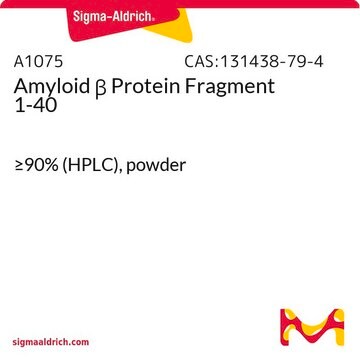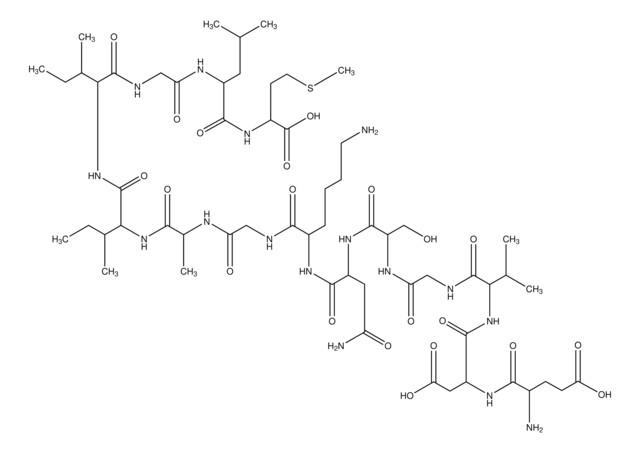A2201
Amyloid β-Protein Fragment 35-25
≥95% (HPLC)
About This Item
Produtos recomendados
Nível de qualidade
Ensaio
≥95% (HPLC)
forma
powder
nº de adesão UniProt
temperatura de armazenamento
−20°C
cadeia de caracteres SMILES
CCC(C)C(NC(=O)CNC(=O)C(CC(C)C)NC(=O)C(N)CCSC)C(=O)NC(C(C)CC)C(=O)NC(C)C(=O)NCC(=O)NC(CCCCN)C(=O)NC(CC(N)=O)C(=O)NC(CO)C(=O)NCC(O)=O
InChI
1S/C45H81N13O14S/c1-9-24(5)36(57-34(62)20-50-40(67)29(17-23(3)4)54-39(66)27(47)14-16-73-8)45(72)58-37(25(6)10-2)44(71)52-26(7)38(65)49-19-33(61)53-28(13-11-12-15-46)42(69)55-30(18-32(48)60)43(70)56-31(22-59)41(68)51-21-35(63)64/h23-31,36-37,59H,9-22,46-47H2,1-8H3,(H2,48,60)(H,49,65)(H,50,67)(H,51,68)(H,52,71)(H,53,61)(H,54,66)(H,55,69)(H,56,70)(H,57,62)(H,58,72)(H,63,64)
chave InChI
IDGOADDOQWKZOX-UHFFFAOYSA-N
Informações sobre genes
human ... APP(351)
Amino Acid Sequence
Descrição geral
Aplicação
Ações bioquímicas/fisiológicas
Outras notas
Código de classe de armazenamento
11 - Combustible Solids
Classe de risco de água (WGK)
WGK 3
Ponto de fulgor (°F)
Not applicable
Ponto de fulgor (°C)
Not applicable
Equipamento de proteção individual
Eyeshields, Gloves, type N95 (US)
Certificados de análise (COA)
Busque Certificados de análise (COA) digitando o Número do Lote do produto. Os números de lote e remessa podem ser encontrados no rótulo de um produto após a palavra “Lot” ou “Batch”.
Já possui este produto?
Encontre a documentação dos produtos que você adquiriu recentemente na biblioteca de documentos.
Os clientes também visualizaram
Nossa equipe de cientistas tem experiência em todas as áreas de pesquisa, incluindo Life Sciences, ciência de materiais, síntese química, cromatografia, química analítica e muitas outras.
Entre em contato com a assistência técnica






